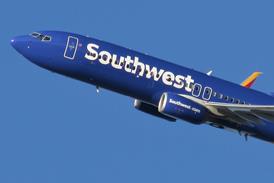Andrzej Jeziorski/TOKYO

Japan's space programme has been tarnished by a series of launch failures that culminated this month in the unsuccessful mission to deliver a government observation satellite into orbit aboard an M-5 rocket.
The failures have led to cuts in funding for important space projects and questions are being asked about the future of the country's launch programme.
While the M-5 launch was a setback, it was the H-2 rocket's failure last November that caused the most consternation, as the vehicle was the focal point of Japan's commercial launch efforts.
The omens were never good for the launch. From an initial target date of 5 August, 1999, the launch of Japan's MT-SAT by the H-2 was delayed three times by technical snags, including a bungled incident with an air-conditioner carrier that damaged the satellite fairing.
This was to be the National Space Development Agency's (NASDA's) first H-2 launch in two years, erasing the stigma of its previous failure in February 1998. But when H-2 No 8 finally lifted off from Tanegashima Space Centre on 15 November, any triumphalism was short-lived: the rocket veered off course 4min into its flight and had to be destroyed remotely, apparently because of cracks in a fuel tank or combustion chamber, which caused the first-stage engine to fail. In the previous H-2 disaster, the rocket failed as a result of a second-stage engine chamber break.
Now, the Japanese space programme has scored an unenviable hat-trick. On 10 February, the M-5 rocket of the education ministry's Institute of Space and Astronautical Science (ISAS) suffered a loss of first-stage engine pressure 41s after its lift-off from Kagoshima Space Centre, failing to deliver the Astro-E X-ray observation satellite into its intended orbit.
This was the M-5's third operational launch, the last having been in July 1998 when an M-5 successfully launched the Nozomi Mars orbiter. Senior industry sources say the latest failure was a result of a nozzle slot break, although ISAS has yet to issue a detailed description of the malfunction.
As a result of three failures - three breakdowns in the launch vehicles' propulsion systems - questions are being asked in government and the space agencies about the production quality of their launch vehicles. Some industry sources say the situation suggests declining skill levels, or carelessness, among technicians and production workers.
According to Mamoru Endo, acting director of the space transportation planning department of NASDA's Office of Space Transportation Systems, the government and the space agency are discussing whether these failures are symptomatic of a deeper flaw in Japan's space programme.
"The government and ourselves are discussing many possibilities. The point is, how do you assure the quality of a product? We are also discussing the relationship between a space agency such as NASDA and industry, and the possibility of some kind of influence from launches not being frequent compared with foreign launchers," says Endo. Since becoming operational, the H-2 has not launched more than one or two payloads a year, he points out.
Up to now, few wanted to launch their satellites on the H-2 because it was too expensive (largely as a result of the soaring value of the yen against the US dollar during the rocket's development, says NASDA): now they cannot do it because it has been cancelled.
On top of that, the November failure also led to a budgetary crackdown which siphoned funding away from development programmes like the Hope-X reuseable orbiter, the Mission Demonstration Test Satellite and the ETS-VIII Engineering Test Satellite, and pumped it into an extended testing and verification programme for a simplified and cut-price version of the rocket known as the H-2A - which was to fly this month, but has been delayed to next February.
In the meantime, additional tests will be carried out on the launcher's new LE-7A and LE-5B engines, made by Mitsubishi Heavy Industries (which also built the H-2's LE-7 and LE-5A motors), as well as the launcher's redesigned SRB-A solid rocket boosters made by Nissan.
All useful resources and personnel from the suspended programmes have been reassigned to the H-2A, says Endo. Some observers say this is a last-ditch attempt to salvage Japan's commercial satellite launch capability, which industry officials privately admit is in a "very, very dangerous" position.
Endo still believes that the space programme will pull through, but adds: "We have to recover the reliability of the space programme and, in many cases, the focus would be the manufacturing process and quality control. So we need to give an incentive to industry to make good products."
Things could look up if the H-2A does prove a reliable launcher: NASDA says Hughes and Loral have reserved payload space. The agreement, conditional on the first two H-2A launches being successful, has been put on ice pending completion of the H-2A verification testing.
Source: Flight International























